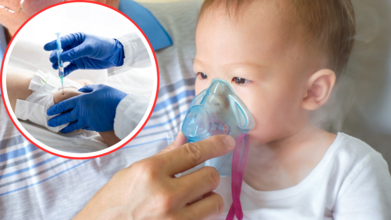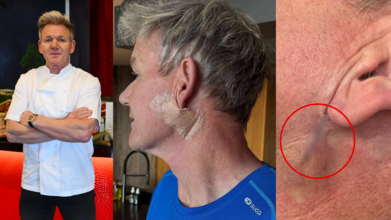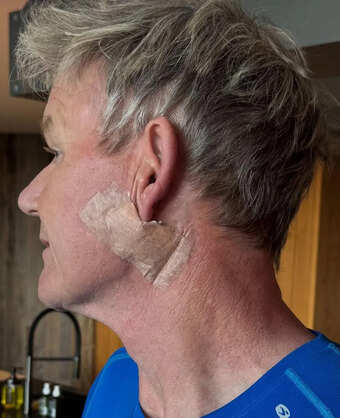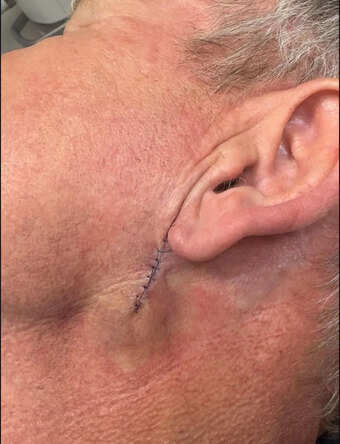- Health Conditions A-Z
- Health & Wellness
- Nutrition
- Fitness
- Health News
- Ayurveda
- Videos
- Medicine A-Z
- Parenting
- Web Stories
Kang Seo-ha, South Korean Actress Dies At 31 After Battling Stage IV Stomach cancer

Credits: Instagram and Canva
South Korean actress Kang Seo-ha, known for her performances in K-dramas like First Love Again and The Flower in Prison passed away at the age of 31 after a long battle with stomach cancer. Her family also confirmed the news on Monday.
Kang's family took to Instagram, and posted a video along with a long note in remembrance of her.
“I still can’t believe it, unnie. Even while enduring such immense pain, you worried about those around you and about me. Even though you couldn’t eat for months, you insisted on paying for my meals with your own card and never let me skip a meal. My angel, who left us far too soon. Even as you endured everything with painkillers, you said you were grateful that it wasn’t worse, and I felt truly ashamed. My dear sister, you went through so much. I hope you are only happy and free from pain where you are now,” the note read.
A memorial service is also being organized at Seoul St Mary's Hospital and the funeral procession is scheduled at 7.40am on July 16 (KST).
Kang Seo Ha's Cancer
It was in 2024 that Kang was diagnosed with advanced stomach cancer. As per reports, she had stage IV stomach cancer and underwent treatment, including multiple rounds of chemotherapy, while she continued to fulfill her professional commitments. However, in mid-2025, her health rapidly declined, leading to her death.
As per the National Cancer Institute, US, cancer stage describes the extent of cancer in the body, which includes the size of the tumor, whether it has spread, and how far has it spread from where it was first formed.
In stage IV stomach cancer, which Kang too was suffering from, the cancer spreads to other body parts, mostly lungs, liver, distant lymph nodes, and the tissue that lines the abdomen wall.
Stage IV stomach cancer, also known as metastatic stomach cancer, occurs when cancer cells spread from the stomach to other parts of the body through the lymphatic system or bloodstream. The new tumors are still made up of stomach cancer cells, not cells from the organs they’ve reached. So, if the cancer spreads to the lungs, it's still considered stomach cancer — not lung cancer — and is referred to as metastatic stomach cancer.
Stomach Cancer And Its Types
The National Cancer Institute, US, notes that stomach cancer starts in the cells lining the stomach. There are various types of stomach cancers including:
Adenocarcinoma of the stomach, which begins in the mucus-producing cells in the innermost lining of the stomach. Nearly all stomach cancers are adenocarcinomas.
Gastroesophageal junction adenocarcinoma (GEJ) is a cancer that forms in the area where the esophagus meets the gastric cardia. GEJ may be treated similarly to stomach cancer or esophageal cancer.
Gastrointestinal neuroendocrine tumors are cancers that begin in neuroendocrine cells (a type of cell that is like a nerve cell and a hormone-making cell) that line the gastrointestinal tract.
Gastrointestinal stromal tumors (GIST) begin in nerve cells that are found in the wall of the stomach and other digestive organs. GIST is a type of soft tissue sarcoma.
Primary gastric lymphoma is a type of non-Hodgkin lymphoma that forms in the stomach. Most primary gastric lymphomas are either mucosa-associated lymphoid tissue (MALT) gastric lymphoma or diffuse large B-cell lymphoma of the stomach.
Also Read: Australia Sees Rise In Meningococcal Disease: What You Need To Know About Symptoms And Vaccination
'Act Now To Protect Yourself ', Warns AMA As Whooping Cases Hit Decades-High, Calls For Vaccinations

Credits: iStock
Australia is facing its largest whooping cough outbreak in more than three decades, with medical leaders sounding an urgent alarm: vaccination is the only reliable shield. Whooping cough, or pertussis, is not a new disease, but it is making a dramatic comeback. In 2024, more than 57,000 cases were reported across Australia the highest number since 1991. And the wave has not slowed. In South Australia, early 2025 data show over 1,000 infections — more than ten times higher than the same period last year.
The national disease surveillance dashboard reports nearly 19,000 cases already in 2025, with hotspots including Queensland, South Australia, and Western Australia’s Kimberley region. Doctors say this is now Australia’s most significant and long-lasting pertussis outbreak in decades.
Pertussis is caused by the bacterium Bordetella pertussis. It spreads easily through coughs and sneezes, thriving in close-contact settings such as households and schools. For most adults, it causes weeks of relentless coughing that disrupts sleep, work, and quality of life. But for infants — especially those too young to be vaccinated it can be life-threatening.
Newborns can develop severe respiratory distress, pneumonia, and even brain damage from prolonged oxygen deprivation during coughing fits. Globally, the World Health Organization estimates that pertussis kills tens of thousands of children every year, most of them under six months old.
AMA’s Urgent Call
The Australian Medical Association (AMA) has issued a clear warning: complacency is dangerous. AMA President Dr. Danielle McMullen described the outbreak as “extremely concerning,” citing both the sheer scale of cases and the drop in vaccination coverage.
“We can’t afford to be complacent,” Dr. McMullen said. “Each year, thousands of lives are lost to respiratory diseases like whooping cough — and we all have a role to play in preventing their spread. Vaccination remains our most powerful defence.”
Why Pregnancy Vaccination is Crucial?
One of the AMA’s strongest messages is directed at expectant mothers. A pertussis-containing vaccine is recommended during every pregnancy, ideally between 20 and 32 weeks. This approach allows protective antibodies to pass from mother to baby through the placenta, shielding the newborn during the critical first weeks of life.
“Maternal vaccination creates antibodies which are passed to the unborn baby and protect them in their first days and weeks of life,” Dr. McMullen explained. “But it doesn’t stop there — ensuring family members and other caregivers are also vaccinated helps create a protective cocoon around infants.”
This cocooning strategy reduces the risk that parents, grandparents, siblings, or caregivers will transmit the infection to newborns who are too young to complete their first immunization schedule.
Vaccines Are Free and Accessible
In Australia, whooping cough vaccines are free for all pregnant women under the National Immunisation Program. Parents are also encouraged to keep their children’s vaccines up to date, particularly during the first six months, when infants are most vulnerable.
For adults, boosters are recommended every 10 years, especially for anyone living with or caring for babies. General practitioners and pharmacies can check vaccination records and provide catch-up doses when needed.
Falling Vaccination Rates and Rising Cases
Part of what makes this outbreak alarming is its timing. Australia has not met its childhood vaccination targets in several regions, and vaccine hesitancy has crept upward in recent years. This leaves pockets of communities vulnerable, creating fertile ground for pertussis to spread.
The AMA warns that failing to address this could undo decades of progress in reducing serious childhood diseases. “Getting vaccinated is one of the simplest and most effective ways you can protect your loved ones and your community,” Dr. McMullen said.
Learning From History
Australia has seen waves of whooping cough before. The last major epidemic peaked in 2011 with over 38,000 cases. But today’s surge is different in scale, surpassing even that crisis and persisting longer. Globally, other countries have also seen cyclical rises in pertussis, underscoring that this is not just an Australian problem.
The key difference between a contained outbreak and a devastating one is vaccination coverage. Experts point to herd immunity thresholds: when enough people are vaccinated, the chain of transmission breaks, protecting those who cannot be immunized.
Though the latest figures come from Australia, health experts stress that this is a global concern. Travel and migration mean outbreaks do not remain confined to national borders. Declining vaccination rates in parts of the United States and Europe could set the stage for similar resurgences.
For families worldwide, the lessons are clear: stay up to date on vaccinations, encourage maternal immunization, and understand that diseases once considered “childhood illnesses of the past” can and do return if immunity gaps open.
Australia’s pertussis outbreak is a wake-up call for all of us. With more than 57,000 cases in a single year and rates still climbing, whooping cough has proven it can resurge when vaccination rates slip.
The AMA’s message is urgent but simple: act now. Pregnant women, parents, and caregivers should prioritize immunization to protect both themselves and those too young to be vaccinated. Free vaccines are available, and the science is clear immunization saves lives. As Dr. McMullen put it, “We must not lose sight of the fact that immunisation saves lives.”
Hard-To-Manage High Blood Pressure Could Now Be Treated With A Pill In Just 12-Weeks

Credits: iStock
High blood pressure, or hypertension, is one of the most common health problems worldwide yet also one of the most stubborn to control. Despite decades of new drugs and treatment combinations, millions of people remain unable to bring their blood pressure down to safe levels. Now, scientists say they may finally have an answer in the form of a pill that works in just 12 weeks.
More than 1.3 billion people globally are living with hypertension. For about half of them, blood pressure remains uncontrolled, and in roughly one in ten, it’s resistant even to multiple medications. That group faces the highest risk of stroke, heart attack, kidney disease, dementia, and premature death.
In the United States alone, nearly half of adults have elevated blood pressure, according to the CDC. For millions of these patients, lifestyle changes like reducing salt intake, exercising more, or losing weight help — but for many, even combining several prescription drugs is not enough. Resistant hypertension has long been a frustrating challenge for both patients and doctors.
Enter baxdrostat, a new pill developed by AstraZeneca. Early data suggest it may finally offer hope to patients with hard-to-control blood pressure. In a large clinical trial known as BaxHTN, which included 796 patients from 214 clinics worldwide, baxdrostat demonstrated significant blood pressure reductions over just 12 weeks.
Patients who took either 1 mg or 2 mg of the drug daily saw their systolic blood pressure drop by about 9–10 mmHg more than those who received a placebo. For context, cardiologists say that even a 5 mmHg reduction can lower cardiovascular risk significantly. Nearly four in ten patients on baxdrostat reached healthy blood pressure targets — compared with fewer than two in ten on placebo.
Professor Bryan Williams, chair of medicine at University College London and principal investigator of the trial, called the findings “a gamechanger.” He explained, “I’ve never seen blood pressure reductions of this magnitude with a drug in such a challenging patient group. This has the potential to help up to half a billion people worldwide.”
Why Existing High Blood Pressure Treatments Fall Short?
To understand why baxdrostat is making headlines, it’s important to look at how blood pressure medications currently work. Most existing drugs target the symptoms of hypertension:
- Diuretics help the body eliminate excess fluid and salt.
- Vasodilators relax arteries to reduce resistance.
- ACE inhibitors and ARBs block hormones that constrict blood vessels.
- Calcium channel blockers ease the workload of the heart by limiting calcium uptake.
While effective for many, these medications often fail in resistant hypertension. Patients may cycle through multiple classes of drugs, often taking three or more at once, and still see little improvement. Side effects like dizziness, fatigue, and swelling can make adherence harder.
How Does The Pill Tackle the Root Cause of Aldosterone?
Baxdrostat takes a different approach. Instead of targeting blood vessels or fluid directly, it blocks an enzyme critical to producing aldosterone, a hormone made in the adrenal glands.
Aldosterone regulates salt and water balance in the body, but some people produce too much of it. Excess aldosterone pushes the body to retain salt and fluid, raising blood pressure and making it unusually hard to control. Scientists have long known that aldosterone plays a central role in resistant hypertension, but attempts to block its production selectively have fallen short — until now.
Williams called baxdrostat “a triumph of scientific discovery,” noting that the drug’s precision in targeting aldosterone could explain why it worked so effectively in patients who had failed multiple treatments.
Could These Results Shift Hypertension Guidelines?
The results of the BaxHTN trial were presented at the European Society of Cardiology Congress in Madrid and published in the New England Journal of Medicine. Cardiologists at the meeting emphasized the potential impact on global treatment guidelines if baxdrostat wins regulatory approval.
Dr. Stacey E. Rosen, volunteer president of the American Heart Association, who was not involved in the trial, noted: “Resistant hypertension is incredibly difficult to manage. Having another option, especially one that directly addresses aldosterone, could be transformative.”
The safety profile of baxdrostat was also encouraging. The most common side effect observed was mild abnormalities in sodium and potassium levels, but these were rare. Unlike some older treatments, baxdrostat did not show widespread adverse effects.
Hypertension is often called the “silent killer” because it produces no obvious symptoms while quietly damaging arteries, the brain, kidneys, and heart. Globally, it contributes to more than 10 million deaths each year, making it the single most important modifiable risk factor for heart disease, the world’s leading cause of death.
Lowering blood pressure is the most effective way to reduce this burden. Studies show that every 10 mmHg reduction in systolic blood pressure cuts the risk of stroke by about 40 percent and heart disease by about 25 percent.
What Comes Next for High Blood Pressure Patients?
For patients who have struggled for years to bring their numbers down despite medication, a once-daily pill that directly addresses a root cause could be life-changing.
Historically, hypertension was most common in Western nations. Today, thanks to changes in diet and lifestyle, low- and middle-income countries carry the heaviest burden. More than half of all people with hypertension now live in Asia, including 226 million in China and nearly 200 million in India.
That global spread makes baxdrostat’s potential even more important. If approved, the drug could not only transform care in the United States and Europe but also provide a critical tool in regions where hypertension is rising fastest and healthcare access is uneven.
AstraZeneca is expected to file for regulatory approval soon. If approved, baxdrostat would be the first new type of hypertension drug in decades. Experts caution, however, that more research is needed to understand how the drug performs over longer periods and across diverse populations.
Still, the initial results have generated rare excitement in a field where progress has been incremental for years. For doctors treating resistant hypertension, a 12-week pill that lowers blood pressure by nearly 10 mmHg represents a genuine breakthrough.
As Professor Williams summed it up, “This could change how we treat one of the most important causes of death and disability worldwide. For patients and clinicians alike, that is hugely exciting.”
Celebrity Chef Gordon Ramsay Reveals Skin Cancer Diagnosis While Sharing Photo With 'A Line Of Stitches'

Credits: Instagram/Gordon Ramsay
Celebrity chef Gordon Ramsay, 58, has revealed he underwent surgery to remove skin cancer, using his platform to raise awareness about sun protection and early detection. In a candid Instagram post, the Michelin-starred chef thanked the medical team at The Skin Associates for their “fast reactive work” in removing a basal cell carcinoma, a common form of non-melanoma skin cancer.
Ramsay’s post included two images, one showing a bandage below his ear and another displaying a long line of stitches stretching from his earlobe to the side of his neck. He downplayed the seriousness with humor, joking, “I promise you it’s not a facelift, I’d need a refund.” But behind the quip lies an important reminder about the dangers of prolonged sun exposure.
The diagnosis and subsequent surgery sparked widespread messages of support from fans and friends, including TV judge Robert Rinder and Ramsay’s daughter Holly, as well as a statement from Cancer Research UK applauding his openness in encouraging people to protect themselves from harmful UV rays.
In his Instagram post, Ramsay urged fans to take sun safety seriously. “Please don’t forget your sunscreen this weekend,” he wrote, highlighting a preventive measure that dermatologists stress as the most effective defense against skin cancer.

The reminder is particularly timely as skin cancer remains the most common form of cancer globally. In the United States alone, more than 3.6 million cases of basal cell carcinoma are diagnosed each year, according to the Skin Cancer Foundation. While most cases are treatable, the emotional and physical toll including scarring from surgical removal can be profound.

Cancer Research UK echoed Ramsay’s warning in a reply to his post: “Seek shade, cover up and apply sunscreen regularly and generously.”
What is Basal Cell Carcinoma?
Basal cell carcinoma (BCC) is the most common type of skin cancer, accounting for nearly 80% of non-melanoma cases. It begins in the basal cells of the epidermis, the outermost layer of skin, which are responsible for generating new skin cells.
Unlike melanoma, which is more aggressive and deadly, BCC is usually slow-growing and rarely spreads to other parts of the body. However, if left untreated, it can cause significant damage to surrounding skin, nerves, and bone. According to the Mayo Clinic, the most frequent cause of BCC is long-term exposure to ultraviolet (UV) radiation from the sun or tanning beds.
The cancer is most likely to appear on areas of the body that receive regular sun exposure—such as the face, neck, ears, scalp, shoulders, and arms.
What Are The Symptoms of Basal Cell Carcinoma?
Symptoms of basal cell carcinoma can vary in appearance, making it easy to overlook in its early stages. Common warning signs include:
- A shiny, translucent bump that may look like a pimple but doesn’t heal
- A flat, scaly patch of skin that slowly enlarges
- A sore that bleeds or oozes and keeps returning
- A scar-like area that feels firm or waxy in texture
While Ramsay did not disclose how long his lesion had been present before diagnosis, health experts emphasize that noticing these subtle changes early can make a critical difference in treatment outcomes.
Why Early Detection and Surgery Can Save Your Life?
Although basal cell carcinoma has a high treatment success rate when caught early, delayed diagnosis increases the risk of disfigurement and more complex surgical procedures. In advanced cases, BCC can grow locally invasive, disfiguring tissue and necessitating reconstructive surgery.
Early diagnosis is possible with less extensive treatments, such as excisional surgery or curettage and electrodesiccation, which destroy cancerous lesions without significantly affecting surrounding skin. More established or recurrent cases can necessitate Mohs surgery, a highly accurate procedure in which cancer cells are excised layer by layer with a microscope until only normal tissue is left.
Early treatment of BCC has an outstanding prognosis, with more than 95% cure, according to the American Cancer Society.
Ramsay's story also serves to point up the global challenge of climbing skin cancer rates. Dermatologists say the surge can be put down to more outdoor activities, tanning culture, and climatic changes that amplify sun exposure. His revelation is a flashback to cricketer Michael Clarke's ordeal when he too had to undergo surgery for skin cancer on his face after years of exposure to sun as he played cricket. Both these public figures are now calling for people to take their health seriously, emphasizing that regular skin checks can save lives.
Although individuals with light skin are at increased risk, skin cancer may occur in all races and ethnicities. In dark skin, BCC is less detectable and therefore takes longer to diagnose, presenting later in the course of disease.
International health agencies emphasize three prevention pillars: avoiding sun exposure during the midday sun, wearing protective clothes and a hat, and using a broad-spectrum sunscreen with a Sun Protection Factor of at least 30.
For Gordon Ramsay, things after his skin cancer operation appear set to go on as normal at his hectic rate of filming, flying, and maintaining an empire of restaurants and television programs. With 17 Michelin stars throughout his career and over 80 restaurants globally—including more than 20 in the US, the chef is still one of food entertainment's most influential figures.
© 2024 Bennett, Coleman & Company Limited

